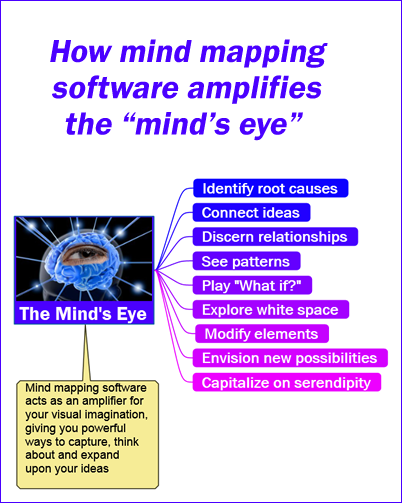 Visionaries have a highly-trained “mind’s eye” – the ability to imagine ideas and concepts as rich visual mental images. I believe mind mapping software acts an “amplifier” for the mind’s eye by making your ideas tangible so you can further develop and share them.
Visionaries have a highly-trained “mind’s eye” – the ability to imagine ideas and concepts as rich visual mental images. I believe mind mapping software acts an “amplifier” for the mind’s eye by making your ideas tangible so you can further develop and share them.
Merriam-Webster’s definition of a visionary is:
“Having or showing clear ideas about what should happen or be done in the future; having or showing a powerful imagination; of or relating to something that is seen or imagined in a dream or vision.”
Being a visionary isn’t some obscure, esoteric ability. It’s essential if you want to be a thought leader in your organization and profession. More often than not, the person with the ability to solve problems and envision new opportunities wins in business. It’s the basis of nearly all entrepreneurship – envisioning something that could be done better, and then forming a new company to develop the idea.
So how, specifically, can mind mapping software help? Here are 9 ways:
1. Identify root causes: Mind mapping software enables you to deconstruct a challenge into its component parts. This can help you to more accurately diagnose what the real problem or root cause is – so you can then focus your creative energy on solving it.
2. Connect ideas: As you brainstorm ideas and add them to your mind map, you will inevitably begin to see connections between them. Mind mapping software makes it easy to move ideas around and combine them to build bigger ideas out of smaller ones.
3. Discern relationships: This is closely associated with connecting ideas. But instead of joining them together, you can simply move them to adjacent branches and make their relationship tangible via a connector or relationship line.
4. See patterns: This is one of the beautiful things about deconstructing challenges and situations visually – you start to see patterns that wouldn’t be obvious if you were simply recording their elements in linear form. This becomes especially powerful as you move topics and ideas around your map, organizing them to make better sense. Each time you move an idea, you change its context and must consider it in a new light. That can spur additional insights, which you can also record in your mind map.
5. Play “What if?” As I just pointed out, mind mapping software makes it easy to do a “brain dump” of ideas and then move them and group them in ways that are meaningful to us. But you can also use this capability to do “What if?” analyses of your map’s contents. Ask yourself, “Would this idea make more sense if I moved it over here?” Then move the topic. If it improves the mind map, then leave it there. If it doesn’t, then drag it back to its old location or simply use your program’s “undo” command to return it to its former state.
6. Explore the white space: Innovation experts call the “white space” the space between existing products or market segments that, for whatever reason, we haven’t explored to date. Think of it as putting your existing product to a new use, or coming up with a new variation that serves a new group of people who weren’t previously your customers. Another possibility is a technological improvement that has made new capabilities possible – which, in turn, make it possible for you to serve a new group or class of customers. Or a company that produces premium products offering a simplified “downscale” version for consumers who could never afford the top-of-the-line version.
White space opportunities are easily seen as you develop a mind map. You can look at two adjacent branches, and say to yourself, “Something’s missing here. This doesn’t quite describe what I’m trying to express in this mind map.” You can then create a new branch in between them that fills in this information gap and gives you a more complete overall picture of your problem, challenge or solution.
7. Modify elements: As you capture the ideas you have expressed in tangible form in a mind map, one powerful way to improve upon them is to take an individual element and modify it, using a brainstorming framework like SCAMPER (a mnemonic for Substitute, Combine, Adapt, Modify/Magnify/Minify, Put to other uses, Eliminate and Reverse/Rearrange).
8. Envision new possibilities: As you’re brainstorming, you will inevitably come up with some wild and crazy ideas that don’t solve the problem, but are so intriguing that you must capture them. Once in tangible form, you may be able to use these impractical ideas as stepping stones to other ideas that do elegantly solve the problem. Or you can use the techniques we’ve already discussed to combine these “left-field” ideas with others to generate a workable solution.
9. Capitalize on serendipity: When you’re brainstorming, fresh stimuli can often lead to new ideas. Mind mapping software can be used to conveniently capture the stimulus itself and the ideas that resulted from it – in essence, making a tangible record of the path your thinking took to reach its final form. Simply record the stimulus as a parent topic, and then create child topics branching off of it to capture all of the ideas that result from it.
What tools and techniques are you using to cultivate your mind’s eye – your abilities to envision new ideas, opportunities and possibilities?

Leave a Reply